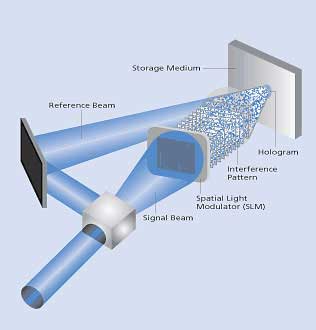InPhase, a U.S. company, has just announced a data recording density significantly higher than any storage technology available on the market to date. The record number achieved by this company is 515 GB of data per square inch.
The three-dimensional light technology (holography) can exponentially increase storage capacity as it utilizes the efficiency of three-dimensional space rather than merely writing data onto the surface of a material. The recording density in this technology is achieved through completely different factors compared to magnetic storage technology. Here, density depends on the number of pixels/bits in a data page, the number of pages stored within a specific volume, the flexibility of the recording material, the thickness of the material, and the wavelength of the recording laser.
 |
Illustration of the data recording process using three-dimensional light by InPhase. |
In InPhase’s experiment, results showed that there were over 1.3 million bits per data page and 320 data pages spaced 0.067 degrees apart, stored within the same volume of material. This collection of data pages is referred to by InPhase as a “book,” and the company’s recording architecture, named PolyTopic, allows for multiple three-dimensional data to be stored within the same volume of material by stacking not only pages but also these “books.”
Three stacked “books” are recorded with a groove measuring 700 micrometers (1 micrometer = one millionth of a meter). The material used by InPhase is called Tapestry, which is 1.5 mm thick with a laser wavelength of 407 nanometers.
InPhase plans to ship drives and software utilizing three-dimensional light technology later this year. The first generation of drives will have a capacity of 300 GB on a single disc with a data transfer speed of 20 Mb/s. Following that will be the launch of a product line with storage capacities ranging from 800 GB to 1.6 TB (terabyte – each TB is equivalent to 1,000 GB).
“The IT community is witnessing extraordinary advancements in data storage capabilities,” stated Wolfgang Schlichting, Research Director in charge of mobile storage at IDC research group. “The new achievement from InPhase marks a significant milestone in the engineering of increased information density, while also showcasing a remarkable increase in storage capacity thanks to three-dimensional light technology. This will also be another promising option to supplement current technologies in the storage field.”
P.K.




















































